
Must-Have Textures for Digital Paper Artists
Texture plays a pivotal role in digital paper art. It’s the subtle layer that elevates flat color into something tactile, believable, and alive. For artists who want their works to read as more than just smooth surfaces, a curated set of textures acts like a versatile toolkit—ready to add depth, warmth, and character with a single brushstroke of blending. In this guide, we’ll explore the textures digital paper artists rely on most, how to use them effectively, and the workflow habits that keep your projects flowing.
Core texture categories you should assemble
Building a library that covers the essentials saves time and sparks creativity. Here are the key categories to prioritize, with practical notes on how they translate to digital canvases:
- Paper textures: think fiber mottling, deckled edges, and subtle grain that mimic traditional sheets. They’re the backbone for letterpress looks, sketchbooks, and vintage-inspired pages.
- Watercolor washes: soft pigment blooms, feathered edges, and translucency that add organic warmth without overpowering line work.
- Grain and noise: micro-texture that creates depth, helping flat areas feel more tactile and alive.
- Canvas and fabric: a gentle weave that introduces rhythm and structure to backgrounds or panel borders.
- Foil and metallic textures: a touch of sparkle or reflective sheen to highlight focal points or accents.
- Halftone and vintage patterns: retro texture that provides character, especially for poster art or zines.
Each category has its own sweet spot. The goal is not to overwhelm the composition with texture but to use it as a supporting voice that guides the viewer’s eye. A well-chosen texture can make a color field feel tactile, a line drawing feel printed, and a background read as carefully considered rather than purely digital.
Practical techniques for applying textures
Texture is most effective when it’s used as an underlayer or a subtle overlay, rather than as the entire surface. Start with a base color or paper texture, then experiment with overlays of watercolor wash or grain on a separate layer. Adjust blending modes—Overlay, Soft Light, and Multiply are common starting points—and play with opacity to integrate texture into your palette. Small adjustments to color balance can shift a texture from cool to warm, changing the mood of your piece without altering its composition.
“Texture is the memory of a surface—if you listen closely, your artwork speaks with a tactile cadence.” —Design educator Maya Kline
For practitioners who juggle gear and schedules, a compact and reliable accessory can keep your setup efficient. If you’re exploring new hardware companions, you might find value in a protective, minimalist case designed for efficiency in motion. The product page linked below showcases a sleek option that pairs well with an on-the-go artist’s workflow: Magsafe Phone Case with Card Holder (Polycarbonate Slim).
Texture workflows to streamline your process
Consistency is the friend of texture exploration. Create a naming convention for textures (for example, “paper-warm-01” or “grain-soft-03”) so you can build a library you trust. When you’re composing scenes, save a few “texture recipes” that pair a base texture with a complementary overlay. This makes it easy to reproduce a signature look across multiple artworks. And don’t hesitate to mix scanned textures with digital ones to achieve a hybrid feel that blends precision with organic charm.
- Test textures at several sizes to ensure they read well on mobile devices as well as desktops.
- Use subtle textures on larger blocks of color to prevent flat areas from reading as digital ink blotches.
- Document your texture settings with quick screenshots or notes so you can revisit a successful blend later.
Finding inspiration and where texture shines
Texture shines when it supports storytelling. A gentle paper texture can frame a portrait, while a bolder halftone pattern can energize a poster design. For visuals that showcase texture in action and offer fresh ideas, the following showcase page provides a curated look at texture applications you can draw from: https://spine-images.zero-static.xyz/6e5e61e4.html.
Remember, texture choices don’t exist in isolation. They influence lighting, depth, and rhythm within a piece. When you pair texture with thoughtful composition, your digital paper artwork gains the tactile presence that readers instinctively respond to. And if you’re curious about how well-equipped your mobile setup is for art on the go, the product page above offers a compact solution that travels well with your creative routine.